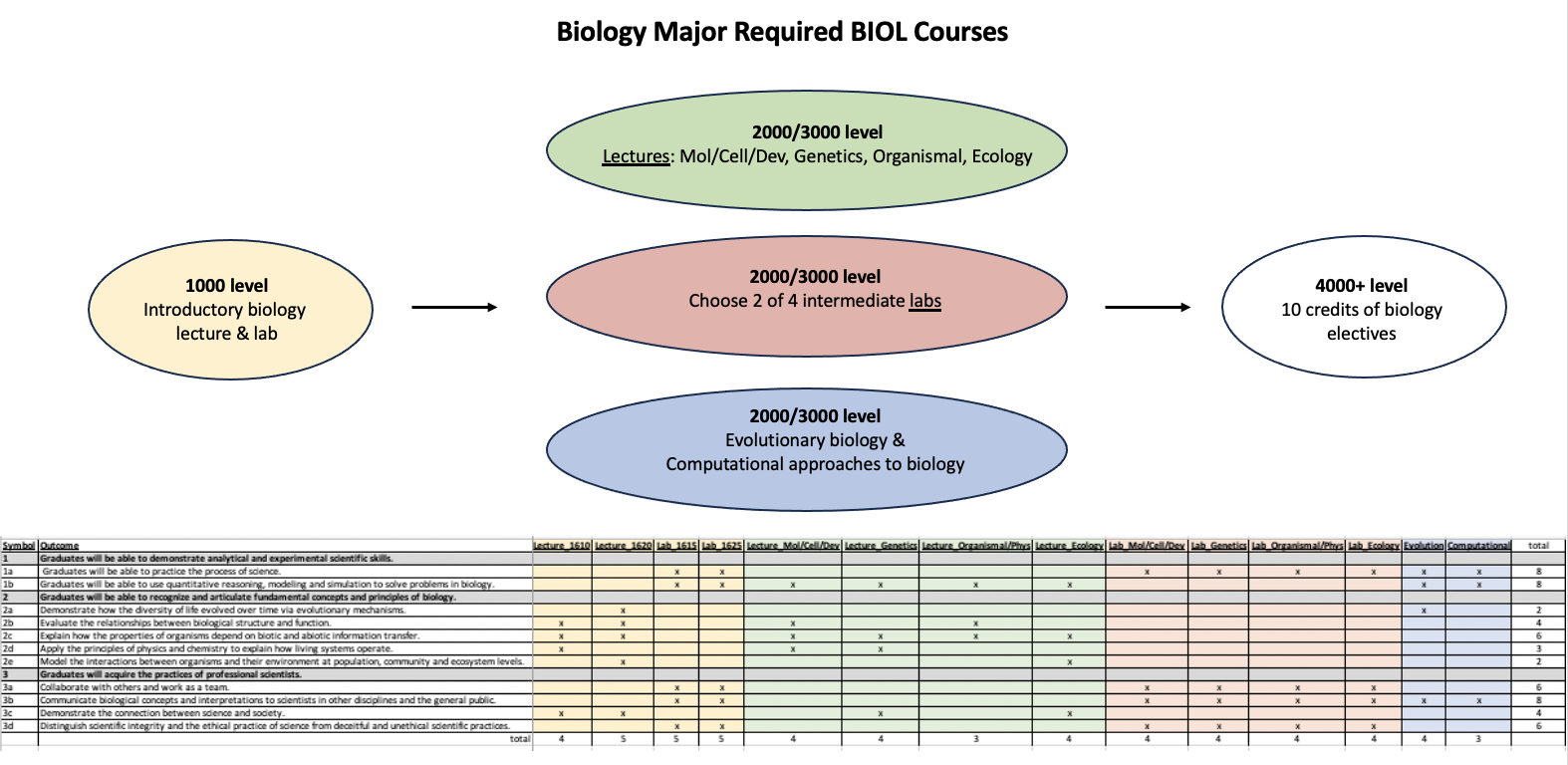Assessment | Biology Major
Biology Emphasis; Cellular/Molecular Emphasis; Ecology and Evolutionary Biology Emphasis; Human Biology Emphasis
We plan to teach to and assess each learning objective multiple times across the curriculum (Curriculum Map link; Biology Major Sheet link). Faculty are provided resources and training (tutorial: Aligning objectives to assessments in Canvas).

Objective 1
Graduates will be able to demonstrate analytical and experimental scientific skills.
- a) Graduates will be able to practice the process of science.
We assess scientific process skills in the introductory-level courses (e.g., BIOL 1615 & 1625) and the intermediate and upper-level courses (e.g., BIOL 3020, 3055, 3060, 3065, 3070, 3085 & 4060). Students in these courses write lab reports and give research presentations. We assess mastery of each section using a grading rubric based on Timmerman et al. (2011), in which each of eight sections is dedicated to a different part of the process of science: introduction: context, introduction: accuracy and relevance, methods, results, discussion: conclusions based on data selected, discussion: limitations of design, discussion: implications of research, references. The eight outcomes are defined in Canvas and aligned with course assignment rubrics. Mastery is 67% (2/3 points on rubric, an "intermediate" score).
- b) Graduates will be able to use quantitative reasoning, modeling and simulation to solve problems in biology.
The five quantitative reasoning outcomes are defined in Canvas to be aligned with course assignments (rubrics, quizzes). We assess these on a scale of 0-3. Mastery is 67% (2/3 points).
Objective 2
Graduates will be able to recognize and articulate fundamental concepts and principles of biology.
Assessment of Objective 2 is carried out through the Gen-Bio MAPS assessment which is administered at the beginning and end of the General Biology sequence (Biology 1610 and 1620), and in the semester preceding graduation.
Assessments are completed online using the survey tool Qualtrics. Results of the Gen-Bio MAPS assessments provide data on mean scores of USU students by core concepts and biology sub-disciplines along with the mean scores from a nationally normed group of 37 universities.
Objective 3
a) Collaborate with others and work as a team.
We assess mastery using a grading rubric. The outcome is defined in Canvas and aligned with course assignment rubrics. Mastery is 67% (2/3 points on rubric, an "intermediate" score).
b) Communicate biological concepts and interpretations to scientists in other disciplines and the general public.
We assess scientific writing in the introductory-level courses (e.g., BIOL 1615 & 1625) and the intermediate and upper-level courses (e.g., BIOL 3020, 3055, 3060, 3065, 3070, 3085 & 4060). Students in these courses write full lab reports or sections of lab reports. We assess mastery of overall writing quality using a grading rubric (link to rubric) based on Timmerman et al. (2011). This outcome is defined in Canvas and aligned with course assignment rubrics. Mastery is 67% (2/3 points on rubric, an "intermediate" score).
We assess oral communication in the introductory-level courses (e.g., BIOL 1625) and the intermediate and upper-level courses (e.g., BIOL 3085). Students in these courses give research presentations. We assess mastery of two aspects of oral communication, clear choice of language and technical use of media, using a grading rubric based on Sevian & Gonsalves (2008). This outcome is defined in Canvas and aligned with course assignment rubrics. Mastery is 67% (2/3 points on rubric, an "intermediate" score).
- c) Demonstrate the connection between science and society.
This outcome is defined in Canvas to be aligned to course assignments (rubrics, quizzes), on a scale of 0-3. Mastery is 67% (2/3 points).
- d) Distinguish scientific integrity and the ethical practice of science from deceitful and unethical scientific practices.
The eleven outcomes are defined in Canvas for alignment with course assignments (rubrics, quizzes), on a scale of 0-3. Mastery is 67% (2/3 points).
Last updated: October 2024

